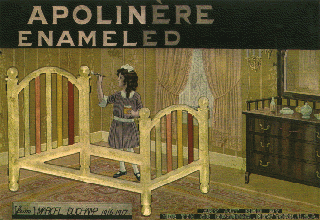
Marcel Duchamp’s Apolinère Enameled, 1916–1917
Rhonda Roland Sherer’s “Marcel Duchamp’s Impossible Bed and Other ‘Not’ Readymade Objects: A Possible Route of Influence From Art To Science”

Marcel Duchamp’s Apolinère Enameled, 1916–1917
Rhonda Roland Sherer’s “Marcel Duchamp’s Impossible Bed and Other ‘Not’ Readymade Objects: A Possible Route of Influence From Art To Science”
“In La Musica Ideal (known in the English-speaking world as ‘The Musicians,’ not a translation but, then, the titles were not always given by Caravaggio), what is the young man at the left doing? Why isn’t he playing an instrument? Does he provide the musicians with an audience?”
(Dick Higgins, “The Importance of Caravaggio”, in Modernism Since Postmodernism: essays on intermedia, p.152)
More precisely, a bad reproduction of it:
There’s a much better reproduction of this in the print edition of this NY Times review of the show at the Cartier-Bresson Foundation, but it’s not on the web. I like this one because it looks like it’s been through too many Photoshop filters.
This part of the Times article is misleading at best:
What Pound felt is impossible to know. Years earlier, he had been interned for mental illness, and in 1960, he lapsed into long periods of depressive silence and stopped writing. And yet, in the image selected by Cartier-Bresson, Pound’s wild hair, burning eyes and tense hands seem to speak volumes about an old man raging against the dying of the light.
“From which I later concluded that if there is one thing as noisy as suffering it is pleasure, especially when there is added to it – failing the fear of having children, which could not be the case here, in spite of the far-from-convincing example in the Golden Legend – an immediate concern with cleanliness.”
(Proust, Sodom and Gomorrah, trans. John Sturrock, p.11)
* * * * *
“Then said he, ‘Make me with child, and after to be delivered, that I may know what pain my mother suffered.’ Which by craft they gave to him a young frog to drink, and grew in his belly, and then he said, ‘But unless ye make me to be delivered I shall slay you all.’ And so they gave him such a drink that he had a vomit and cast out the frog, and bare him on hand that because that he abode not his time it was misshapen, which yet he made to be kept.
Then for his pleasure he set Rome afire, which burned seven days and seven nights, and was in a high tower and enjoyed him to see so great a flame of fire, and sang merrily.
He slew the senators of Rome to see what sorrow and lamentation their wives would make.
He wedded a man for his wife. He fished with nets of gold thread, and the garment that he had worn one day he would never wear it nor see it after.
Then the Romans seeing his woodness, assailed him and pursued him unto without the city, and when he saw he might not escape them, he took a stake and sharped it with his teeth, and therewith stuck himself through the body and so slew himself. In another place it is read that he was devoured of wolves. Then the Romans returned and found the frog, and threw it out of the city and there burnt it.”
(The Golden Legend, the life of Saint Peter)
* * * * *
“Many writers allude to it in Naaman’s case; that Constantine the head of the whole earth had leprosy no one mentioned; at least none of his fellow citizens, but perhaps some foreigner or other, to be given no more credence than that other fellow who wrote about wasps building their nest in Vespasian’s nostrils, and about the frog taken from Nero at birth, whence they say the place was called the Lateran, for the frog (rana) is concealed (latere) there in its grave. Such stuff neither the wasps themselves, nor frogs, if they could speak, would have uttered! [I pass over the statement that boys’ blood is a remedy for leprosy, which medical science does not admit;] unless they attribute this to the Capitoline gods, as though they were wont to talk and had ordered this to be done!”
Lorenzo Valla, Discourse on the Forgery of the Alleged Donation of Constantine, trans. Christopher B. Coleman, pp.153–155)
<
p align=”center”> *
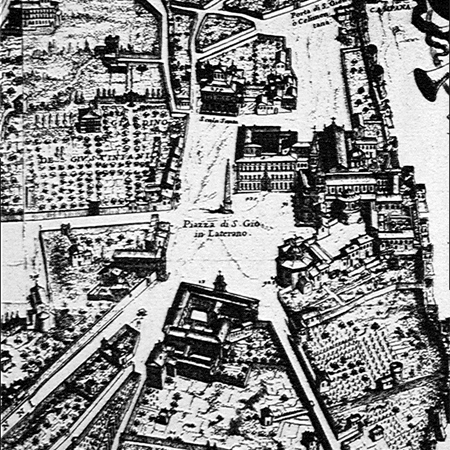
(G. B. Falda, Pianta di Roma (detail), 1676)
* * * * *
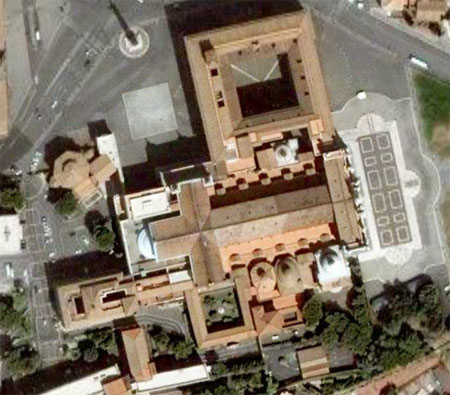
(Google Earth of the same)
(from Metropolis, via BLDGBLOG).
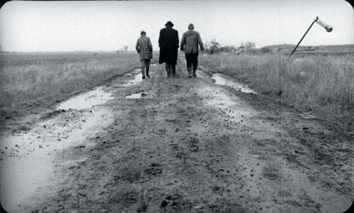
(representative still from Béla Tarr’s Sátántangó)
(Anselm Kiefer’s Böhmen liegt am Meer)
“Bohemia Lies by the Sea”
Are these houses green, I once more enter a house.
Are these bridges safe, to walk I have good ground.
All loving effort lost for ever, I lose it happily.
lf not I myself then someone else as good as I.
lf here a word adjoins to me, I let it join.
If Bohemia lies still on the sea, I believe the seas.
And if I believe in the sea, I still can hope for land.
lf it’s I myself it’s everyone just as much as I.
I have no wishes any more. I wish to run aground.
Aground – towards the sea, to find Bohemia.
Wrecked, I wake up peacefully.
I have grounded my belief and shall be lost no longer.
Come here, you from Bohemia, sailors, whores, and ships
without a staying. Won’t you be Bohemians, you Illyrians, Veronese
Venetians. Play those comedies to make us laugh
Before we cry. Go wrong a hundred times
as I went wrong and always failed examinations,
yet I passed them all, each and every time.
Passed them like Bohemia which one fine day
was relieved down to the sea and now lies on the shore.
Still I adjoin to a word and to another country,
and ever more adjoin to all there is however slightly,
Come from Bohemia here, a vagrant, who has nothing, whom nothing keeps,
gifted with vision to see from the sea-struggle land of my choice.
(Ingeborg Bachmann, trans. Peter Filkins)
(Gerhard Richter, Mailand: Dom, 1964)
(Gerhard Richter, Domplatz – Mailand, 1968)
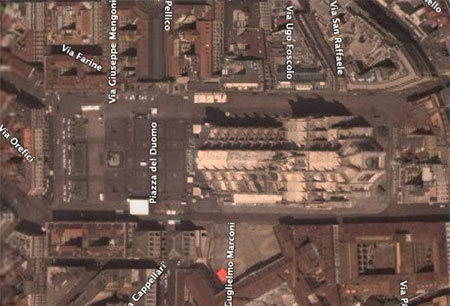
(from Google Earth)
requisite poem:
“Milan Cathedral”
Through light green haze, a rolling sea
Over gardens where redundance flows,
The fat old plain of Lombardy,
The White Cathedral shows.
Of Art the miracles
Its tribe of pinnacles
Gleam like to ice-peaks snowed; and higher,
Erect upon each airy spire
In concourse without end,
Statues of saints over saints ascend
Like multitudinous forks of fire.
What motive was the master-builder’s here?
Why these synodic hierarchies given,
Sublimely ranked in marble sessions clear,
Except to signify the host of heaven.
(Herman Melville, from Timoleon, 1891)
(La Fornarina, Raffaello Sanzio, 1518–1519)
(Portrait of a Young Woman in a Turban (Beatrice Cenci?), Guido Reni(?) ,ca. 1662)